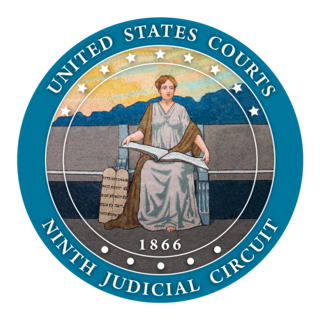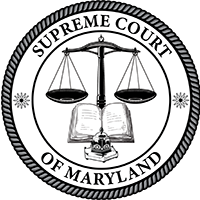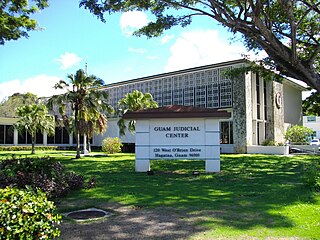Related Research Articles
In the United States, a state supreme court is the highest court in the state judiciary of a U.S. state. On matters of state law, the judgment of a state supreme court is considered final and binding in both state and federal courts.

The United States courts of appeals are the intermediate appellate courts of the United States federal judiciary. They hear appeals of cases from the United States district courts and some U.S. administrative agencies, and their decisions can be appealed to the Supreme Court of the United States. The courts of appeals are divided into 13 "Circuits". Eleven of the circuits are numbered "First" through "Eleventh" and cover geographic areas of the United States and hear appeals from the U.S. district courts within their borders. The District of Columbia Circuit covers only Washington, DC. The Federal Circuit hears appeals from federal courts across the entire United States in cases involving certain specialized areas of law.

The United States Court of Appeals for the Ninth Circuit is the U.S. federal court of appeals that has appellate jurisdiction over the U.S. district courts for the following federal judicial districts:

The Supreme Court of Maryland is the highest court of the U.S. state of Maryland. The court, which is composed of one chief justice and six associate justices, meets in the Robert C. Murphy Courts of Appeal Building in the state capital, Annapolis. The term of the Court begins the second Monday of September. The Court is unique among American courts in that the justices wear red robes.

The Supreme Court of Florida is the highest court in the U.S. state of Florida. It consists of seven justices—one of whom serves as Chief Justice. Six members are chosen from six districts around the state to foster geographic diversity, and one is selected at large.

The Supreme Court of Nevada is the highest state court of the U.S. state of Nevada, and the head of the Nevada Judiciary. The main constitutional function of the Supreme Court is to review appeals made directly from the decisions of the district courts. The Supreme Court does not pursue fact-finding by conducting trials, but rather determines whether legal errors were committed in the rendering of the lower court's decision. While the Court must consider all cases filed, it has the discretion to send appeals to the Nevada Court of Appeals for final resolution, as well as the power to determine the jurisdiction of that court.

The Alaska Supreme Court is the state supreme court for the U.S. state of Alaska. Its decisions are binding on all other Alaska state courts, and the only court its decisions may be appealed to is the Supreme Court of the United States. The Alaska Supreme Court hears appeals from lower state courts and also administers the state's judicial system.
The Alaska Court System is the unified, centrally administered, and totally state-funded judicial system for the state of Alaska. The Alaska District Courts are the primary misdemeanor trial courts, the Alaska Superior Courts are the primary felony trial courts, and the Alaska Supreme Court and the Alaska Court of Appeals are the primary appellate courts. The chief justice of the Alaska Supreme Court is the administrative head of the Alaska Court System.
The Alaska Court of Appeals is an intermediate court of appeals for criminal cases in the State of Alaska's judicial department, created in 1980 by the Alaska Legislature as an additional appellate court to lessen the burden on the Alaska Supreme Court. The court of appeals consists of a chief judge and three associate judges, who are all appointed by the governor of Alaska and face judicial retention elections every eight years; the chief judge of the court of appeals is selected from among the four by the chief justice of the supreme court to serve a two-year term.
The Tennessee Plan is a system used to appoint and elect appellate court judges in Tennessee. It is largely patterned after the Missouri Plan, and an earlier version in Tennessee was called the Modified Missouri Plan. At the end of every judge's eight-year term following a judicial appointment to the highest courts, retention elections are held, which have the option of whether each judge shall be retained through a yes-no option. This system applies to the Tennessee Supreme Court, the Tennessee Court of Appeals, and the Tennessee Court of Criminal Appeals.

The Supreme Court of Guam is the highest judicial body of the United States territory of Guam. The Court hears all appeals from the Superior Court of Guam and exercises original jurisdiction only in cases where a certified question is submitted to it by a U.S. federal court, the Governor of Guam, or the Guam Legislature. The Supreme Court of Guam is the ultimate judicial authority on local matters. In the past, appeals of questions involving the U.S. Constitution or federal laws or treaties were heard by a three-judge appellate panel of the U.S. District Court of Guam, from which appeals could be further taken to the United States Court of Appeals for the Ninth Circuit, but this is no longer the case. Since 2006, the court's decisions have only been appealable to the Supreme Court of the United States, in line with the practice regarding the highest courts of the 50 states. The Court sits in the Monessa G. Lujan Memorial Courtroom, which is on the third floor of the Guam Judicial Center in Hagatna, Guam.

The Georgia Court of Appeals is the intermediate-level appellate court for the U.S. state of Georgia. The court is a single entity with 15 judges. The judges are assigned into five divisions of three judges each, with the assignments changed annually. Cases are randomly assigned to one of the divisions, with the constraint that the number of active cases in each division is kept close to equal. Its courtroom is on the second floor of the Nathan Deal Judicial Center.

The Mississippi Court of Appeals is the intermediate-level appellate court for the state of Mississippi. A creation of the Mississippi Legislature, the court began operations in 1995 for the purpose of relieving a backlog of cases before the Supreme Court of Mississippi.
The Government of Guam (GovGuam) is a presidential representative democratic system, whereby the president is the head of state and the governor is head of government, and of a multi-party system. Guam is an organized, unincorporated territory of the United States with policy relations between Guam and the US under the jurisdiction of the Office of Insular Affairs.

The South Carolina Court of Appeals is the intermediate-level appellate court for the state of South Carolina.

The Supreme Court of Mississippi is the highest court in the state of Mississippi. It was established in 1818 per the terms of the first constitution of the state and was known as the High Court of Errors and Appeals from 1832 to 1869. The court is an appellate court. The court consists of nine justices elected in nonpartisan contests from three districts to serve eight-year terms. The most senior justice serves as the chief justice. It is housed in the Carroll Gartin Justice Building in Jackson, Mississippi, the state capital.
In law, an appeal is the process in which cases are reviewed by a higher authority, where parties request a formal change to an official decision. Appeals function both as a process for error correction as well as a process of clarifying and interpreting law. Although appellate courts have existed for thousands of years, common law countries did not incorporate an affirmative right to appeal into their jurisprudence until the 19th century.

Sevcik v. Sandoval is the lead case that successfully challenged Nevada's denial of same-sex marriage as mandated by the state's constitution and statutory law. The plaintiffs' complaint was initially filed in the U.S. District Court for the District of Nevada on April 10, 2012, on behalf of several couples denied marriage licenses. These couples challenged the denial on the basis of the U.S. Constitution's Fourteenth Amendment guarantee of equal protection.
The Nevada Judiciary is the judicial branch of the Government of Nevada, which is responsible for applying the Constitution and law of Nevada. It consists of the Supreme Court, Court of Appeals, district courts, justice courts, and municipal courts. The Supreme Court oversees the administration of the judiciary.

A general election was held in the U.S. state of Nevada on November 3, 2020. To vote by mail, registered Nevada voters must ensure each ballot is postmarked by November 3 and received by November 10, 2020.
References
- ↑ "Court of Appeals". 14 December 2022.
- ↑ "State Ballot Questions". Nevada Secretary of State. Retrieved 2016-12-11.
- 1 2 Ritter, Ken (11 November 2014). "Officials setting up new Nevada Court of Appeals". Reno Gazette-Journal. Gannett. Retrieved 26 January 2015.
- ↑ "Court of Appeals". Nevada Judiciary. 14 December 2022. Retrieved 2023-05-28.
